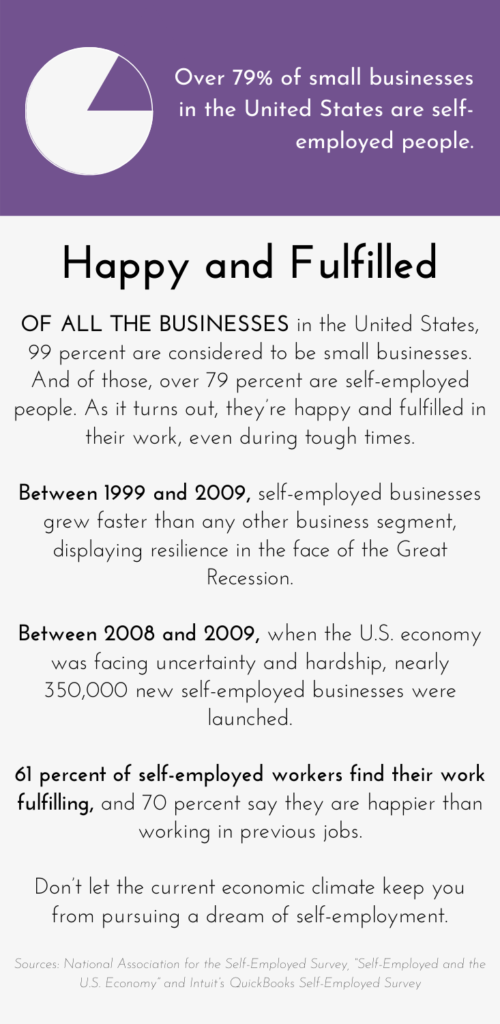A year ago, if we had listed the industries we thought were recession proof, they would have included movie theaters, restaurants, food and alcoholic beverage companies, and home improvement retailers. Today, we know none of these industries are safe from certain types of recession events.
So how can you keep income flowing and guarantee control over your future and your family’s security?
Well, there may not be any 100 percent guarantees, but there is a way to take more control of your future: turning your side hustle into a full-time gig.
If you’re driving for a ridesharing company or running tasks, your hustles will likely remain on the side. But if you have a side hustle that is scalable—one that can grow while remaining profitable with your available time and money resources—then you could be an island of financial security in a sea of uncertainty.
The important first move is to select the right side hustle, if you haven’t already. (See our sidebar “Ask The SideHustler” below if you are in need of inspiration.) Then you can follow these steps to turn your bonus cash into your bread and butter.
1. Evaluate demand.
Before you commit to buying all your eggs with the money from your side hustle basket, make sure there’s enough demand. Are your products and services popular enough to provide a full-time living? If you’re local and you’ve tapped your market, can you easily expand without a lot of additional resources? If you’re online, how much will it cost you in time, design services, and advertising fees to attract customers through ads?
2. Lay a financial foundation.
If you still have a primary job, divert as much money as you can into savings. This will offset the risk of spending more time in your side hustle and less in your job. Aim for enough savings to cover three to six months of expenses, including those for your side hustle expansion. If you’re making this move out of necessity and don’t have the luxury to start with a lot of savings, try socking away a small percentage of everything you earn to start an emergency fund. Even 2 percent can add up: Save 2 percent of $10,000 and you’ve got $200 saved up for a rainy day. It’s not much, but now we know how to spend that emergency money on what matters.
3. Expand, but don’t go nuts.
You don’t need a fancy office right away or three new assistants. What you do need in order to expand is more customers. Look at where you can grow your reach and how you can reach them. Then increase your marketing and advertising accordingly.
4. Improve systems.
Bringing more people into your business will backfire if you don’t have the proper systems in place to support them. Add a virtual assistant, accounting software, or a customer service hotline to help deal with new customer needs and growing administrative requirements.
5. Spread the word.
Finally, let the world know that you’re growing. Show up on social media with video and let people see who’s behind the brand. Post often, and interact with people who might be looking for what you sell. Don’t just sell online. Be helpful. Be the expert on what you know.
If you’re in financial fear, upping your side hustle game can feel urgent. But it’s usually a gradual process. To speed things along, focus on areas of quick wins: Circle back with existing clients and try to upsell them on additional services; touch base with previous clients and ask for referrals and testimonials you can post online; and focus on building relationships with business owners in related fields who might offer a helping hand.


Q: I want to diversify my income by starting a side hustle, but as a parent, I can’t afford to lose time and money on something that will fail. Any ideas on something low risk?
A: The good news is there are still a lot of ways to earn extra money. Any new venture is going to come with a certain amount of risk, but with the right commitment, support and skills, you can diversify your income sources and help provide more security to your family. Here are some characteristics of the lowest risk side hustles:
Low skill entry: Unless you’re diving into the creative or consulting world, a side hustle that doesn’t require you to have any particular training is often the fastest way to earn extra money.
Large consumer pool: If you build it, they won’t automatically come—unless it’s something they actually want to see. Make sure you’re stepping into a field with a wide audience of ideal consumers.
Profitable track record: Your neighbor might tell you that going into affiliate websites is the next big thing, but if their affiliate site hasn’t had any SEO success in the last year, that’s not a good sign. Look for a side hustle that has a proven track record of success among people who have similar skills, availability and resources as you have.
Existing inventory or service model: If you want to take the pain out of sales, opt for a business that you can run with someone else’s products or service model. Direct selling is ideal for people who already believe in a company’s products and want to earn extra money.
Mentorship or support: If you get into trouble with your new gig, who will you turn to for help? It’s vital to answer this question early. Look for a company that allows you to use their training resources, while running an independent business.
This article originally appeared in the July/August 2020 issue of SUCCESS magazine.
Photo by Flamingo Images/Shutterstock.com


